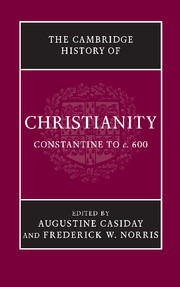Book contents
- Frontmatter
- Introduction
- Part I Christianity: Regional Developments
- Part II Christianity Contested
- 5 Religious dynamics between Christians and Jews in late antiquity (312–640)
- 6 Christianity and paganism, I: Egypt
- 7 Christianity and paganism, II: Asia Minor
- 8 Christianity and paganism, III: Italy
- 9 Christianity and paganism, IV: North Africa
- 10 The intellectual debate between Christians and pagans
- 11 Christianity and Manichaeism
- 12 Heresiology: The invention of ‘heresy’ and ‘schism’
- Part III Christian Culture and Society
- Part IV Christian Beliefs and Practices
- Index
- Map 1 The Roman empire, c. 400">
- References
6 - Christianity and paganism, I: Egypt
from Part II - Christianity Contested
Published online by Cambridge University Press: 28 March 2008
- Frontmatter
- Introduction
- Part I Christianity: Regional Developments
- Part II Christianity Contested
- 5 Religious dynamics between Christians and Jews in late antiquity (312–640)
- 6 Christianity and paganism, I: Egypt
- 7 Christianity and paganism, II: Asia Minor
- 8 Christianity and paganism, III: Italy
- 9 Christianity and paganism, IV: North Africa
- 10 The intellectual debate between Christians and pagans
- 11 Christianity and Manichaeism
- 12 Heresiology: The invention of ‘heresy’ and ‘schism’
- Part III Christian Culture and Society
- Part IV Christian Beliefs and Practices
- Index
- Map 1 The Roman empire, c. 400">
- References
Summary
One notices it first in the early documents of Coptic art: crosses in the shape of the ancient hieroglyph for ‘life’, symbols of Christian triumph juxtaposed to archaic desert beasts, tombs awash with classical nymphs and heroes, saints posed in armour, on horseback, wielding weapons against demonic chaos just like the god Horus several centuries earlier. Clearly the assimilation of Christianity in Egypt took place in creative ways that challenge older notions of ‘conversion’. Christianisation certainly served as more than just a way for peasants to keep their heathen ways, as many nineteenth-century historians judged it. Yet it was also more complex a process than the arrival of spiritual truth to a culture bereft of its gods and temples. In essence we may say that, over the third to sixth centuries, a distinctive Christianity came about in the land of Egypt both through conversation with active local traditions of religious expression and simply in ‘being there’ – taking root in a landscape where people pursued the same work and demanded of any religious system the same attention to needs as in earlier ages.
Christianisation and syncretism in the local sphere
To understand the Christianisation of Egypt as well as the conflicts with native religion that this process entailed, we need to make some tentative distinction between the Christianity of texts, literate creedal formulations and central authority, on the one hand, and, on the other, the Christianities assembled locally in villages, the products of quotidian needs, local church or monastic personalities, and regional lore. These two spheres of Christianity would in no way have been divorced from each other, for local expressions – stories of monks and saints, ritual traditions – influenced the literate central culture, while the texts, liturgy and notions of orthodoxy that developed in urban centres (and that were themselves often in competition) exerted much influence on village culture.
Keywords
- Type
- Chapter
- Information
- The Cambridge History of Christianity , pp. 173 - 188Publisher: Cambridge University PressPrint publication year: 2007
References
- 4
- Cited by

